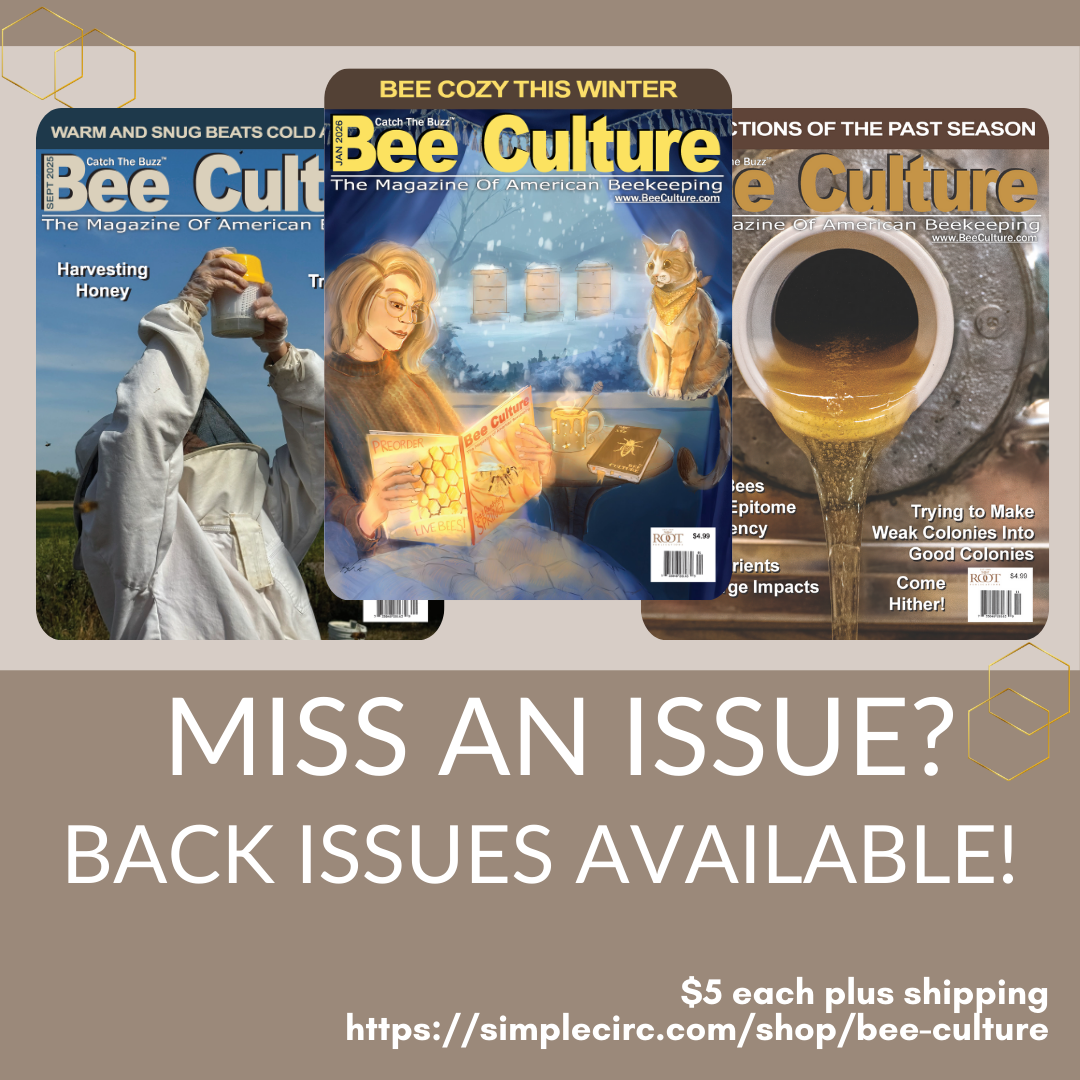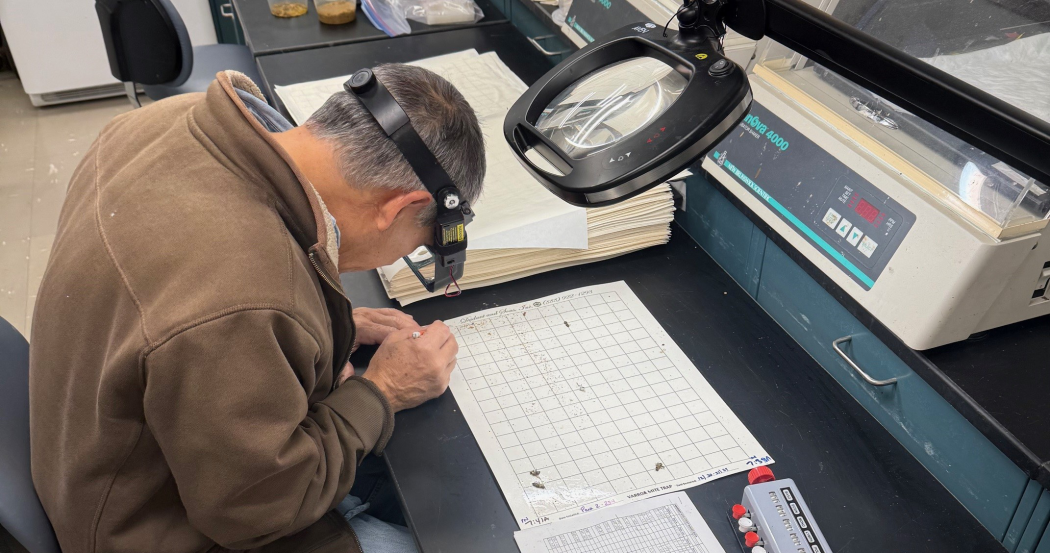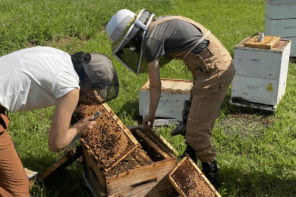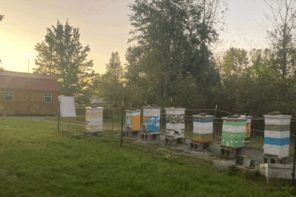Click Here if you listened. We’d love to know what you think. There is even a spot for feedback!
Read along below!
Found in Translation
Bite, or at Least Fight, the Mite
By: Jay Evans, USDA Beltsville Bee Lab
Hope springs eternal and now is a good time for beekeepers to enact positive changes for the genetics of their bee colonies. This starts with putting the best genes forward for the smackdown of Varroa mites. Fortunately, several researchers have mastered methods we mortals might use to minimize mites. Assuming you or a dear friend has successfully overwintered bee colonies, consider harnessing whatever traits helped those survivors greet the Spring in your climate and in the face of mite threats. My USDA colleague Steven Cook, among others, is a relentless proponent of grafting earlier from his strongest overwintered colonies, and ideally ones with low mite counts, to self-queen splits or re-queen newly arrived packages. This taps into both an ability to survive local conditions and proof these bees have faced the toughest overwinter challenge: mites and their associated viruses. Even better, the drones flying early on should themselves be the products of stronger overwintered colonies, giving a rare chance to tap into desirable dads as well as moms.
The science behind using steady selection for fitness was bolstered by a study published in December, 2024, by Alvaro De la Mora and colleagues at the University of Guelph (De la Mora, A.; Goodwin, P.H.; Emsen, B.; Kelly, P.G.; Petukhova, T.; Guzman-Novoa, E. “Selection of honey bee (Apis mellifera) genotypes for three generations of low and high population growth of the mite Varroa destructor”. Animals 2024, 14, 3537. https://doi.org/10.3390/ani14233537). As evidenced by the long list of accomplished authors, this study was done at a scale that would be tough for most of us. Still, the principles are doable, the outcome was stunning, and if something this could be done in a coordinated way there would be a net gain for colony survival.
Their main selection tool was the longstanding sticky board. Colonies with low mite counts on these boards were distinguished from high-count colonies by simply counting mites after three days. They compared mite drop in dozens of colonies between the start of the season (May, this study WAS done in Canada) and late Summer (August). Their breeding yardstick was the fold-change in mite counts over that season, i.e., mites in August/mites in May. From the start, they observed good populations of low-mite (low-Varroa growth or LVG) and high-mite (high-Varroa growth or HVG) colonies. These colonies were tracked over Winter and used to graft queens sourced from either LVG or HVG mother colonies for dozens of colony splits the following Spring. That grafting/requeening part was the biggest challenge of this study as it was done across ten apiaries to ensure the maintenance of genetic diversity but this seems doable for a guild of beekeepers or a decent-sized breeding operation. The results were impressive in year one, reflecting substantial standing variation in mite resistance, but grew even stronger in subsequent years, leading to colonies that showed a 90% reduction in seasonal mite growth versus their high-mite neighbors. This translated into bees that survived better when exposed experimentally to mites, bees that harbored lower levels of the devastating Deformed wing virus, and colonies that had a remarkable three-fold higher chance of surviving harsh Canadian Winters. The selected colonies did equally well in Summer growth patterns and survival experiments when they were mite-free, suggesting that the downside for achieving low mite growth and high overwinter success was minimal.
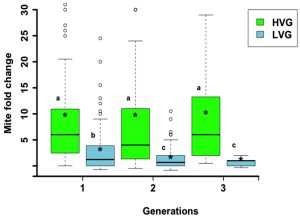 The ‘mite-biting’ trait of worker bees was proposed in the 1990’s as another measurable behavior for selecting mite-resistant stock. Greg Hunt, Krispn Given and others at Purdue University soon used this trait as a breeding tool for mite-resistant bees, leading to a Purdue mite-biting stock that has achieved some notoriety and training dozens of queen breeders in the identification of this genetic trait. Hongmei Li-Byarlay, who took part in these early studies, is continuing the fight to breed bees that bite. With her Central Ohio University students (and Krispn), she has published two important papers describing this trait and developing new tools breeders might use to exploit it. The first, led by two students Jada Smith and Xaryn Cleare (Smith J, Cleare XL, Given K and Li-Byarlay H. (2021) “Morphological changes in the mandibles accompany the defensive behavior of Indiana mite biting honey bees against Varroa destructor”. Front. Ecol. Evol. 9:638308. doi: 10.3389/fevo.2021.638308), noted that worker bees from colonies showing a tendency to bite mites (as evidenced by missing limbs in mites found on sticky boards) actually had slightly different mouthparts when compared to bees from less shark-like colonies. Perhaps counter-intuitively, mite biters had slightly shorter mandibles (the pinching mouthparts of bees) as measured by the longest stretch of their cutting blade. They confirmed this result for two additional mite-resistant lineages in a November, 2024 paper (Li-Byarlay, H., Young, K., Cleare, X., Cao, D., & Luo, S. (2024) “Biting behavior against Varroa mites in honey bees is associated with changes in mandibles, with tracking by a new mobile application for mite damage identification”. Apidologie, 56(1), 3. doi:10.1007/s13592-024-01126-z). Why would mite-biting bees have smaller mouthparts? The authors argue that a smaller pair of scissors might actually make bees more agile when liberating mite limbs. Anecdotally, mite-resistant Apis cerana honey bees also have smaller mouthparts, although the authors did not contrast this size with the smaller overall body size found for these Asian bees. Mite-biting is an extremely rare event to witness, but it will be great if someone can set up stages to see if scissor size supports successful snipping (say that three times fast). As a second tool that could help breeders screen for mite-biters, the authors have developed an Android application that can be used to quantify bite rates using high-resolution mite mug-shots, https://zenodo.org/records/14045618.
The ‘mite-biting’ trait of worker bees was proposed in the 1990’s as another measurable behavior for selecting mite-resistant stock. Greg Hunt, Krispn Given and others at Purdue University soon used this trait as a breeding tool for mite-resistant bees, leading to a Purdue mite-biting stock that has achieved some notoriety and training dozens of queen breeders in the identification of this genetic trait. Hongmei Li-Byarlay, who took part in these early studies, is continuing the fight to breed bees that bite. With her Central Ohio University students (and Krispn), she has published two important papers describing this trait and developing new tools breeders might use to exploit it. The first, led by two students Jada Smith and Xaryn Cleare (Smith J, Cleare XL, Given K and Li-Byarlay H. (2021) “Morphological changes in the mandibles accompany the defensive behavior of Indiana mite biting honey bees against Varroa destructor”. Front. Ecol. Evol. 9:638308. doi: 10.3389/fevo.2021.638308), noted that worker bees from colonies showing a tendency to bite mites (as evidenced by missing limbs in mites found on sticky boards) actually had slightly different mouthparts when compared to bees from less shark-like colonies. Perhaps counter-intuitively, mite biters had slightly shorter mandibles (the pinching mouthparts of bees) as measured by the longest stretch of their cutting blade. They confirmed this result for two additional mite-resistant lineages in a November, 2024 paper (Li-Byarlay, H., Young, K., Cleare, X., Cao, D., & Luo, S. (2024) “Biting behavior against Varroa mites in honey bees is associated with changes in mandibles, with tracking by a new mobile application for mite damage identification”. Apidologie, 56(1), 3. doi:10.1007/s13592-024-01126-z). Why would mite-biting bees have smaller mouthparts? The authors argue that a smaller pair of scissors might actually make bees more agile when liberating mite limbs. Anecdotally, mite-resistant Apis cerana honey bees also have smaller mouthparts, although the authors did not contrast this size with the smaller overall body size found for these Asian bees. Mite-biting is an extremely rare event to witness, but it will be great if someone can set up stages to see if scissor size supports successful snipping (say that three times fast). As a second tool that could help breeders screen for mite-biters, the authors have developed an Android application that can be used to quantify bite rates using high-resolution mite mug-shots, https://zenodo.org/records/14045618.
Breeding bees using mite counts or mite damage is not a permanent fix. As always, the mite empire will strike back, “try your puny mandibles on THESE heavily armored legs”, and both random and cost-based factors will chip away at forward progress (I coined the term “trait rot” for this in a May 2018 Bee Culture essay, a term that quite emphatically has not caught on but describes the fact that for every push forward there can be multiple setbacks, https://beeculture.com/found-in-translation-15/). Despite this impermanence, these methods complement brood hygienics and other holistic methods for improving bee genetics in the face of their number one threat. If you have a sizable gene pool, or if you and a band of sisters and brothers can develop a regional effort, consider a focus this year on identifying and tracking low-drop mite colonies. Perhaps you can check the dropped mites for missing limbs, and put a tag on performers and non-performers to see how they do this season and into next Spring. When you identify winners, it seems worthwhile to share those genetics with neighbors. For sure share your results with Hongmei and Krispn; scientists are always keen to see how their tools fare in the hands of researcher-beekeepers. Meanwhile, keep an eye out for commercial breeders with the wherewithal to use these and more sophisticated tools to produce resistant, rot-free, queens for sale.


